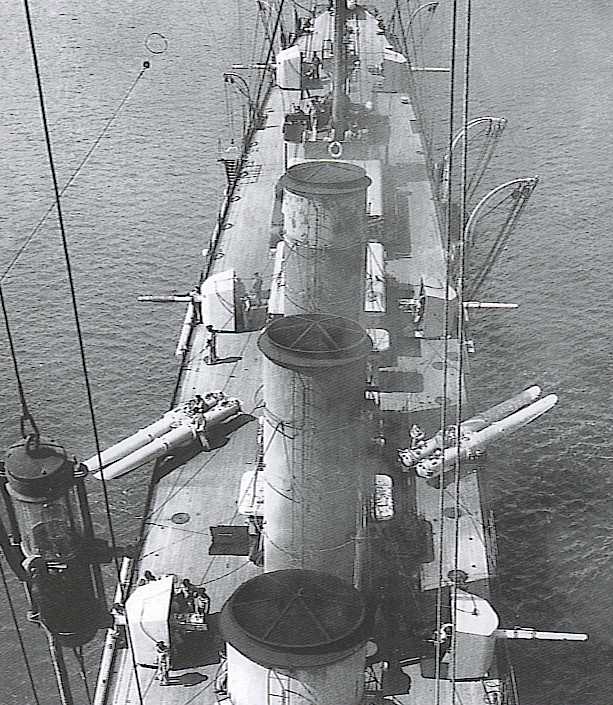
Originally designed in 1910 by Škoda and used on Austria-Hungarian pre-dreadnoughts, cruisers and destroyers. Many ships carrying these guns were ceded to the Italians at the end of World War I. The Italians were quite impressed with the design and virtually copied it, one of the few changes being a loose liner. Considered by the Italians to be a good AAA weapon.
In 1930 the Soviet Navy purchased 10 twin mounts from Italy which were installed on the light cruisers Chervona Ukraina and Krasny Kavkaz. These were known in Russia as "Minizini" after the mount's designer, Commander Minisini.
Many sources state that these guns or a close variation with a 4" (10.2 cm) bore rather than a 100 mm (3.9") bore were used on the Argentine cruisers of the Veinticinco de Mayo class. However, recent research has found that they were a unique design built by Odero-Terni based upon the 102 mm/45 Schneider-Armstrong guns.
The original Škoda design was A tube, jacket and breech ring screwed onto both the A tube and the jacket. Used a horizontal sliding breech block.
Nomenclature note: The lengths of these guns were almost identical, the differences as noted in their designations was strictly the result of the way each nation measured barrel length. See "Definitions and Information about Naval Guns" for further information.
| Designation | Austria-Hungary: 10 cm/50 (3.9") K10 and K11 1 Italy: 100 mm/47 (3.9") Models 1924, 1927 and 1928 Russia: 100 mm/50 (3.9") "Minizini" 2 |
|---|---|
| Ship Class Used On | Austria-Hungary: Radetzky, Admiral Spaun, Helgoland, Tatra and Triglav II classes
Italy: Cesare, Trento, Zara and all Condotteri classes, San Giorgio as rearmed Russia: Chervona Ukraina and Krasny Kavkaz |
| Date of Design | Škoda: 1907
OTO: 1924, 1927 and 1928 |
| Date In Service | Austria-Hungary: 1910
Italy: 1919 (war prizes), 1930 (OTO production) Russia: 1930 |
| Gun Weight | Austria-Hungary: 4,453 lbs. (2,020 kg)
Italian: 4,800 lbs. (2,177 kg) Russian version: 4,894 lbs. (2,220 kg) |
| Gun Length oa | Austria-Hungary: N/A
Italian: 196.3 in (4.985 m) Russian: 196.85 in (5.000 m) |
| Bore Length | Austria-Hungary: N/A
Italian: 185.0 in (4.700 m) Russian: 184.8 in (4.694 m) |
| Rifling Length | Russian: 148.9 in (3.782 m)
Others: N/A |
| Grooves | 26 |
| Lands | N/A |
| Twist | N/A |
| Chamber Volume | 473.5 in3 (7,760 cm3) |
| Rate Of Fire | Austria-Hungary and Italy: 8 - 10 rounds per minute
Russia: 12 rounds per minute |
- ^K10 and K11 were nearly identical, with the K10 designed for use in casemates while the K11 was designed for use on open decks.
- ^Although the dimensions given above for the Russian version of this weapon are slightly different, I would tend to believe that both these and the Italian guns would be identical or nearly so.
| Type | Fixed |
|---|---|
| Complete Round Weight | Austria-Hungary
HE 57.7 lbs. (26.2 kg) Italian
Russian
|
| Projectile Types and Weights | Austria-Hungary
HE 30.3 lbs. (13.75 kg) Italian
Russian
|
| Bursting Charge | Austria-Hungary
N/A Italian
Russian
|
| Projectile Length | Austria-Hungary
N/A Italian
Russian
|
| Propellant Charge | Austria-Hungary
14.6 lbs. (6.6 kg) RP Italian
Russian
|
| Muzzle Velocity | Austria-Hungary
2,887 fps (880 mps) Italian
Russian
|
| Working Pressure | Russian: 17.8 tons/in2 (2,800 kg/cm2) |
| Approximate Barrel Life | Russian: 500 rounds |
| Ammunition stowage per gun | Italian da Barbiano class
Peace: 400 rounds War: 600 rounds Others: N/A |
| Elevation | Distance |
|---|---|
| 14 degrees | About 12,030 yards (11,000 m) |
| Elevation | Distance |
|---|---|
| 45 degrees | 16,670 yards (15,240 m) |
| AA Ceiling | About 33,000 feet (10,000 m) |
| Shell | Distance |
|---|---|
| 34.83 lbs. (15.8 kg) HE mod 1915 | 20,280 yards (18,546 m) |
| 34.83 lbs. (15.8 kg) HE mod 1928 | 21,400 yards (19570 m) |
| Designation | Austria-Hungary - Single Mounts
Battleships: Radetzky (20) 1a Cruisers 2a 3a: Admiral Spaun (7) and Helgoland (9) Destroyers: Tatra (2) and Triglav II (2) Italy - Twin Mounts 4a Soviet Union - "Minizini" Twin Mounts
|
|---|---|
| Weight | Single Mounts: 7.1 tons (7.24 mt)
Twin Mounts: 14.8 tons (15.0 mt) |
| Elevation | Austria-Hungary: -4 / +18 degrees
Italian: -5 / +85 degrees Russian: -5 / +78 degrees |
| Elevation Rate | Russian: 7 degrees per second
Others: N/A |
| Train | 360 degrees |
| Train Rate | Russian: 13 degrees per second
Others: N/A |
| Gun recoil | Russian: 22.84 - 23.62 in (58 - 60 cm)
Others: N/A |
| Loading Angle | Any 6a |
- ^The Radetzky class had sixteen guns in casemates and four guns in the superstructure around the funnels.
- ^Gun sights were calibrated up to 10,000 meters (10,940 yards). During the First Battle of Durazzo in December 1915, gunlayers on the scout cruiser Helgoland aimed at the mast tops of the pursuing British cruisers as the range was over 11,000 meters (12,030 yards).
- ^Late in World War I, the Austro-Hungarian Navy concluded that these guns were an ineffective cruiser weapon and planned to replace them on the Helgoland class with five 15 cm guns taken from decommissioned warships, but none were so modified.
- ^Italian heavy cruisers had their two after mountings removed in 1937 and replaced by twin 37 mm/54 mountings.
- ^After Chervona Ukrania was sunk in November 1941, two of her 100 mm (3.9") mounts were fitted to Krasnyi Kavkaz during a refit in the autumn of 1942.
- ^The Italian mounts could be loaded at any angle by having the cradle trunnions automatically change position such that the breech remained at about the same height regardless of the elevation. Although a technical marvel, this slowed the overall elevation speed and made it difficult for the gun to follow a fast-moving aircraft. As a result, these weapons were generally limited to firing barrage patterns.
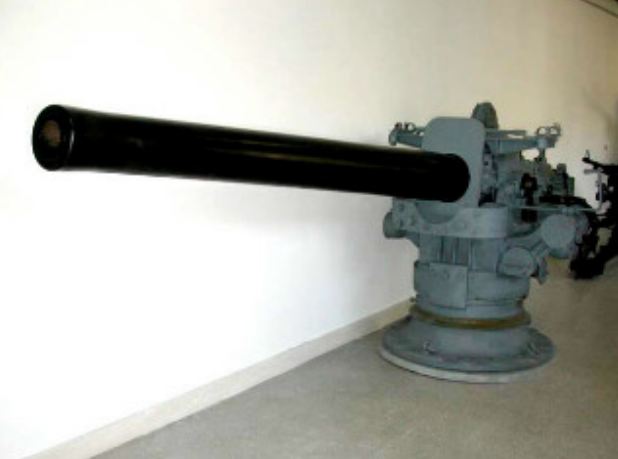
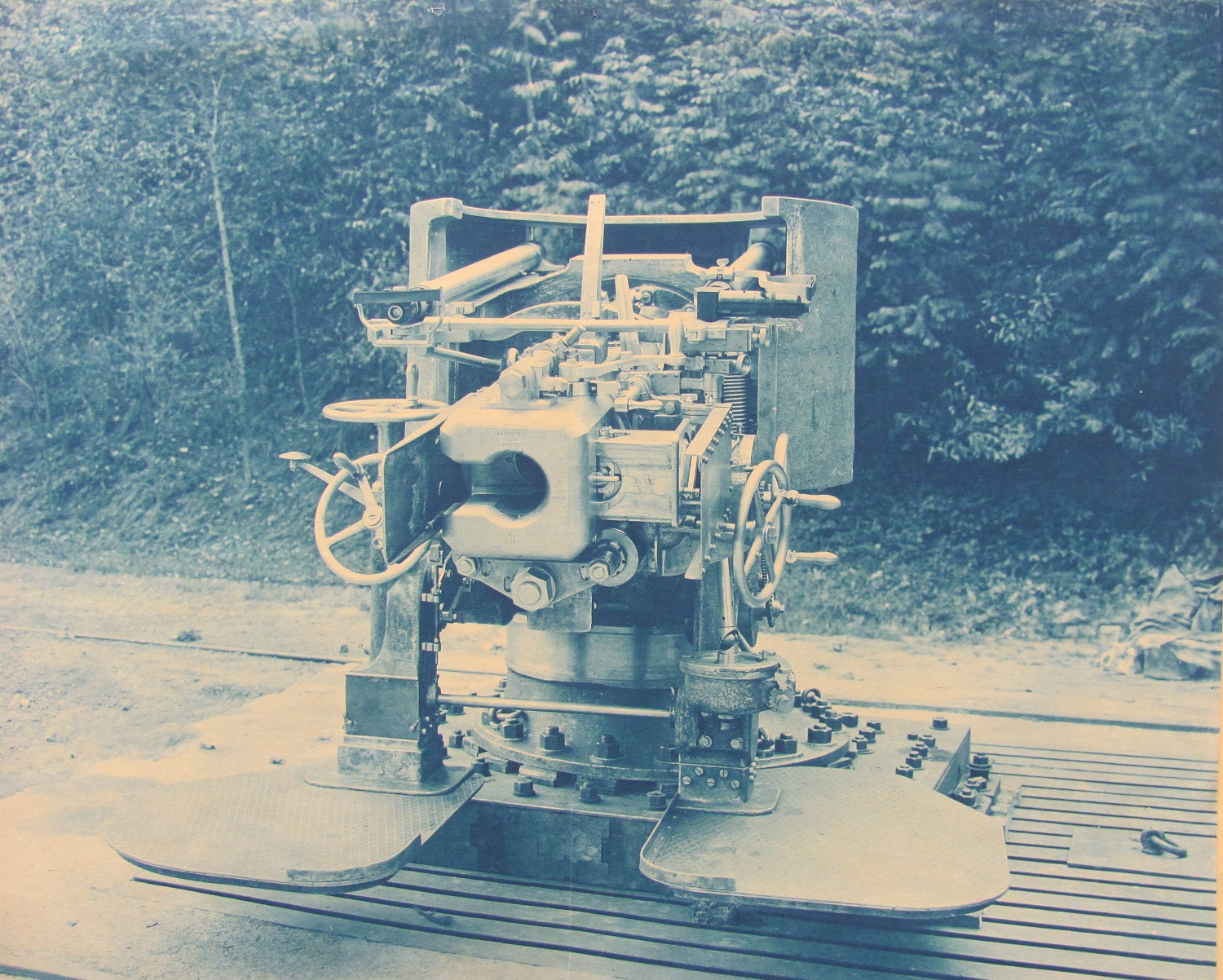
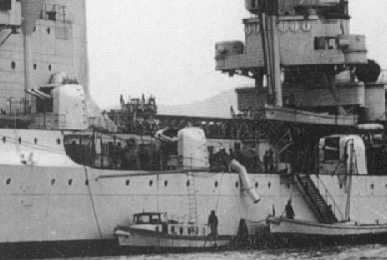
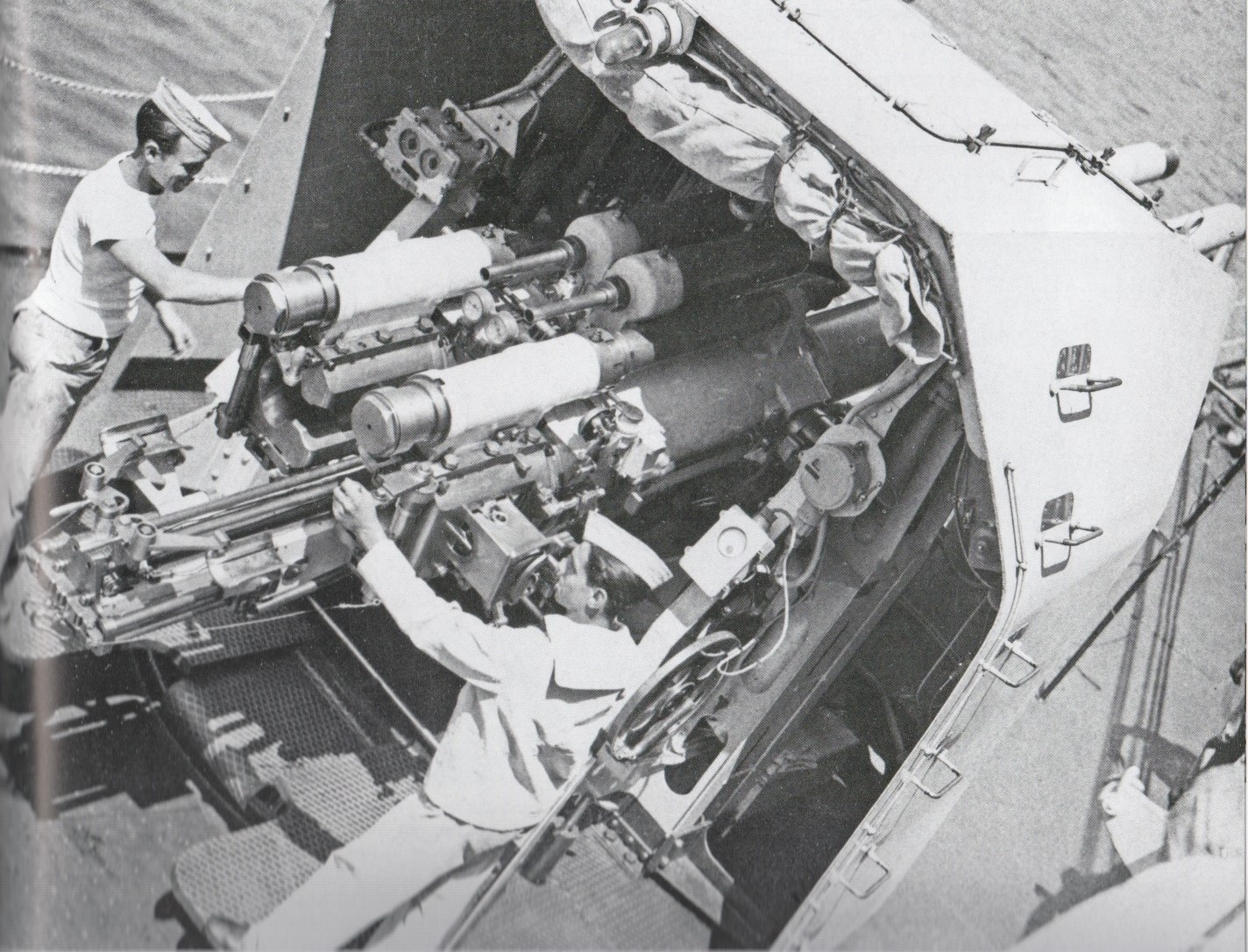
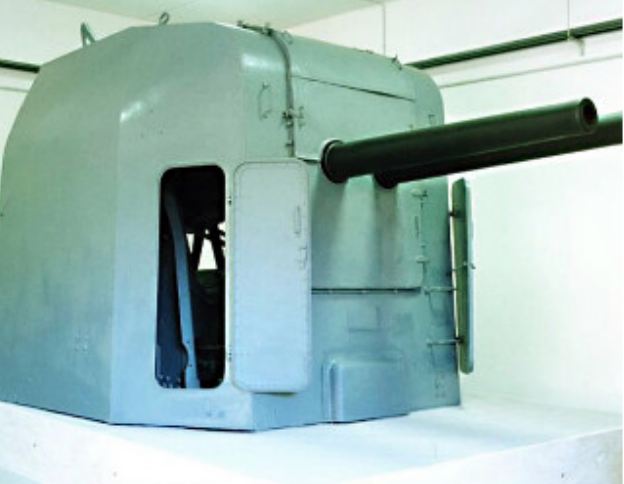
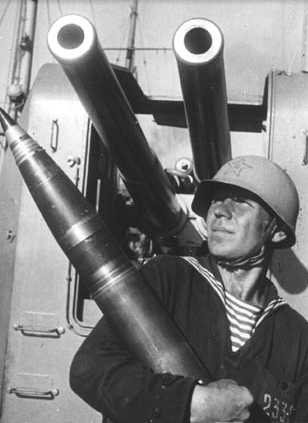
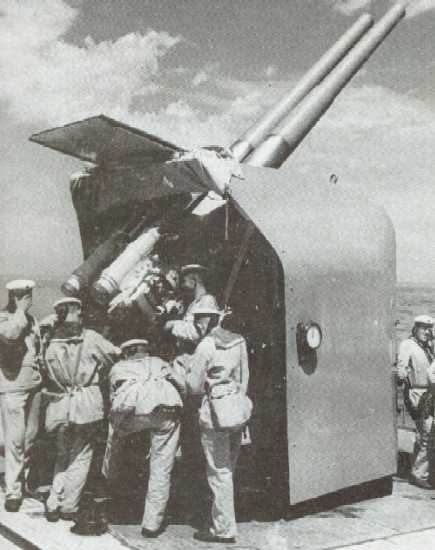
"Italian Heavy Cruisers: From Tento to Bolzano" by Maurizio Brescia and Augusto de Toro
"Naval Weapons of World War Two" by John Campbell
"Italian Warships of World War II" by Aldo Fraccaroli
"Anatomy of the Ship: The Cruiser Bartolomeo Colleoni" by Franco Gay and Valerio Gay
"The Battle of Otranto Straits: Controlling the Gateway to the Adriatic in WWI" by Paul G. Halpern
"Sovetskie Boevye Korabli 1941-45: IV Vooruzhnie" (Soviet Warships 1941-45: Volume IV Armament) by A.V. Platonov
"Entsiklopedia Otechestvennoi Artillerii" (Encyclopedia of Fatherland (Russian) Artillery) by A.V. Shirokorad
"Cruisers of World War Two" by M.J. Whitley
---
"Flot vo Slavu Rossii" (Fleet in Honor of Russia) CD
K.u.k. Kriegsmarine (Hrsg.), Exerzierreglement für die Bedienung des 10 cm G. L/50; Pola 1915
---
Original research by Mihály Krámli, author of "A Használhatatlan Lövegtornony Mítosza: Legenda Vagy Valóság?" [The Myth of the Useless Turret: Legend or Reality?] and
"Az Osztrák-Magyar Monarchia Csatahajói: 1904-1914" [Austro-Hungarian Battleships and Battleship Designs: 1904-1914]
{Link - Hungarian to complete book in pdf form and Link - English}.
Paperback copies printed on A4 paper and shipped from Hungary are available. Contact NavWeaps by clicking on the Contact link above or below for more information.
---
Tony DiGiulian's personal files
---
Special help from Vladimir Yakubov, Erwin F. Sieche and Georg v. Rauch
21 September 2008 - Benchmark
23 September 2012 - Added pictures of museum guns
10 January 2015 - Improved description of trunnion elevation system
09 December 2022 - Converted to HTML 5 format, moved the Veinticinco de Mayo guns
19 June 2024 - Added use on Radetzky class
08 January 2025 - Added photograph of twin mount on a Zara Class Heavy Cruiser
